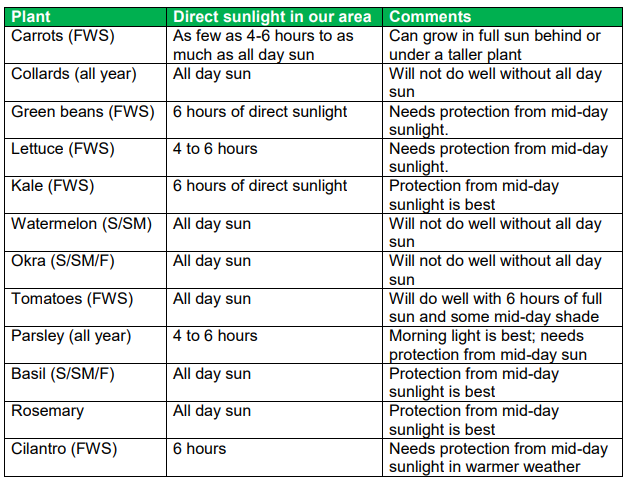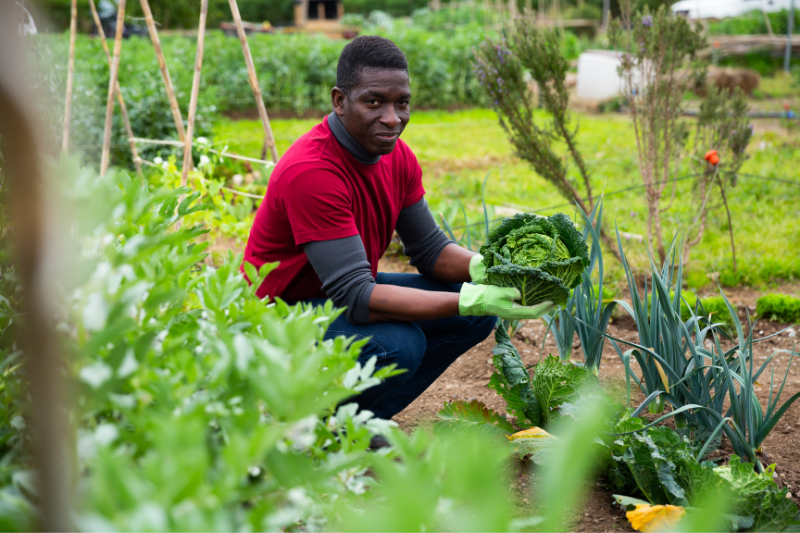BY JOYCE WOODSON, Garden Enthusiast
Zen: a state of calm attentiveness in which one’s actions are guided by intuition rather than by conscious effort
Organic Gardening for Beginners
Getting started: Focus on light
This blog is a beginner’s guide to organic vegetable gardening. In this series, you will find the basics – light, moisture, soil/nutrients and climate – as well as tips to create your first garden, diseases and bugs we encounter here, and resource links for more information or services from experts.
I have been gardening for decades and today grow most of the vegetables we eat. I hope Garden Zen will prepare you to start your own garden, even if it’s just one pot on your patio.
Light is our first focus because it’s one of the basics we cannot change, the other being climate. We can water during dry spells and amend poor soil, but if we have insufficient light, our garden will be limited to only plants that can tolerate low light levels, primarily herbs.
Too often, new gardeners select an area because it’s a convenient location in their yard, but your ideal spot may have poor light. When you scout out your yard for the perfect garden location, consider where the sun is in the morning, mid-day and afternoon.
Watch it at different times of the day to see if a building or tree canopy casts shadows. Our best growing season here is fall and winter, when the sun is lowest in the sky. Trees, buildings, and even privacy fences that don’t create a shadow during the summer may in winter.
You may find the only adequate light is in your front yard, so why not mingle vegetables with traditional landscaping? I have five garden areas, the largest of which is in my front yard. This bed is mixed with enough landscape plants to defy recognition as a vegetable and fruit tree garden from the street.
How much light is enough – how much is too much? Yes, it’s “light” outside during the day, but vegetables produce the energy they need to live from direct sunlight, so they all need some exposure to sunlight every day.
Usually, seeds and seedlings list specific sunlight requirements on their packaging, using terms such as full sun, direct sun, part sun, or part shade. Few provide the number of hours to define what those terms mean. And to complicate things even more, the same seeds and seedlings are sold all over the country, but the sunlight in Michigan is less intense than in Florida. Full sun here may scorch a plant that grows well in full sun in Michigan.
So many questions about such a simple thing: sunlight. Here are a few answers:
- Full sun is all day long sun. Direct sun means there is no shading but doesn’t define the amount of sun. Part sun or part shade reflects all exposure to the sun; these plants do not tolerate direct sun all day. No vegetable grows in full shade.
- Most vegetables require about six hours of direct sunlight every day. This sunlight could be the first-morning sun to 1 p.m., 10-4 p.m., or noon to dusk. Even three hours in the morning and three hours in the late afternoon with dappled sun/shade in between would be fine.
- If you are growing in containers, you “could” move the containers to catch the light at different times of the day. But be honest with yourself! Are you really going to do that every day? No judgments here, but most of us will not remember.
- If your garden bed is in all-day sun, try planting taller full sun plants so they can cast afternoon shade on plants that need it. For example, collards are happy with all-day sun, and they grow tall enough to provide shade for vegetables that can grow with less intense afternoon sunlight, like green beans and carrots.
- Many herbs will do well with 4-6 hours of sun. Herbs generally prefer morning sun, and many will struggle with full exposure to the all-day sun.
Here is a chart with sunlight recommendations for a few essential vegetables and herbs*

*Not all vegetables and herbs grow at the same time of year.
The following key shows when the vegetables are best grown here: F/fall, W/winter, S/spring, and SM/summer.
 Real estate agent Joyce Woodson loves gardening and sharing what she knows. The founder of “Straw Hat Gardening,” she has taught classes on basic organic gardening and provided garden consultations.
Real estate agent Joyce Woodson loves gardening and sharing what she knows. The founder of “Straw Hat Gardening,” she has taught classes on basic organic gardening and provided garden consultations.






